Chaofan Ma
Unsupervised Domain Adaptation via Similarity-based Prototypes for Cross-Modality Segmentation
Oct 23, 2025Abstract:Deep learning models have achieved great success on various vision challenges, but a well-trained model would face drastic performance degradation when applied to unseen data. Since the model is sensitive to domain shift, unsupervised domain adaptation attempts to reduce the domain gap and avoid costly annotation of unseen domains. This paper proposes a novel framework for cross-modality segmentation via similarity-based prototypes. In specific, we learn class-wise prototypes within an embedding space, then introduce a similarity constraint to make these prototypes representative for each semantic class while separable from different classes. Moreover, we use dictionaries to store prototypes extracted from different images, which prevents the class-missing problem and enables the contrastive learning of prototypes, and further improves performance. Extensive experiments show that our method achieves better results than other state-of-the-art methods.
Contrast-Unity for Partially-Supervised Temporal Sentence Grounding
Feb 18, 2025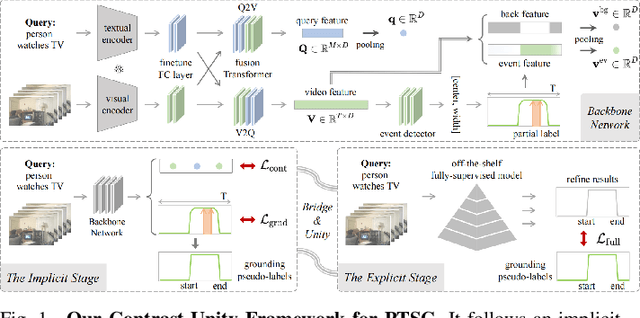
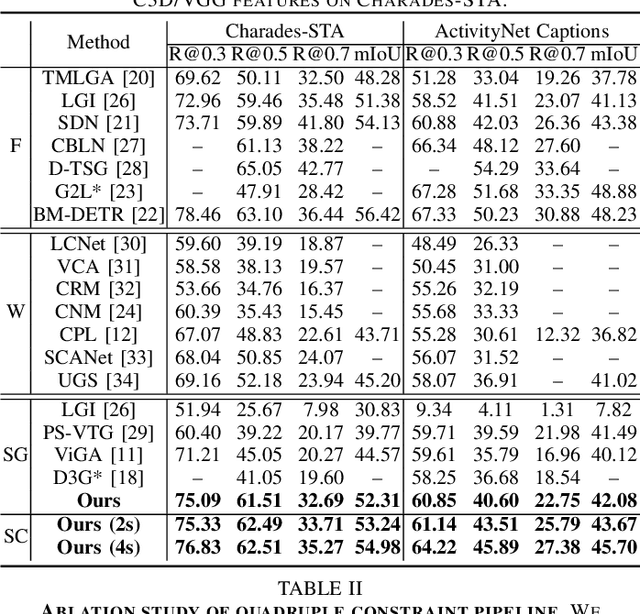
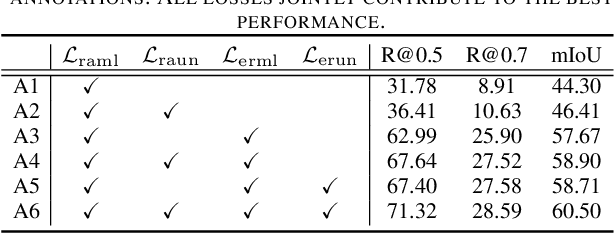
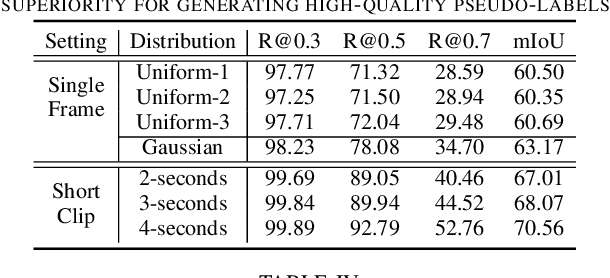
Abstract:Temporal sentence grounding aims to detect event timestamps described by the natural language query from given untrimmed videos. The existing fully-supervised setting achieves great results but requires expensive annotation costs; while the weakly-supervised setting adopts cheap labels but performs poorly. To pursue high performance with less annotation costs, this paper introduces an intermediate partially-supervised setting, i.e., only short-clip is available during training. To make full use of partial labels, we specially design one contrast-unity framework, with the two-stage goal of implicit-explicit progressive grounding. In the implicit stage, we align event-query representations at fine granularity using comprehensive quadruple contrastive learning: event-query gather, event-background separation, intra-cluster compactness and inter-cluster separability. Then, high-quality representations bring acceptable grounding pseudo-labels. In the explicit stage, to explicitly optimize grounding objectives, we train one fully-supervised model using obtained pseudo-labels for grounding refinement and denoising. Extensive experiments and thoroughly ablations on Charades-STA and ActivityNet Captions demonstrate the significance of partial supervision, as well as our superior performance.
ReMamber: Referring Image Segmentation with Mamba Twister
Mar 26, 2024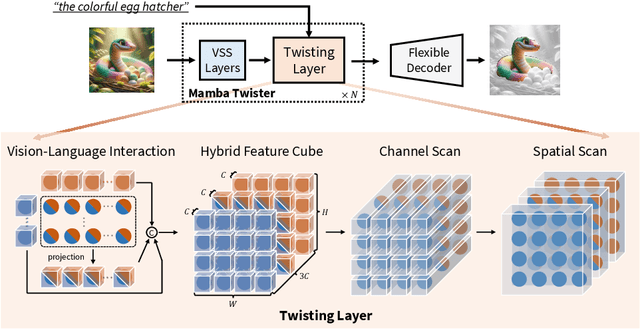
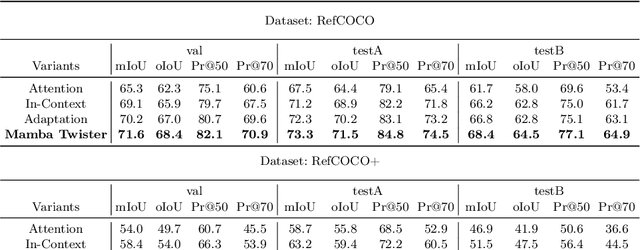
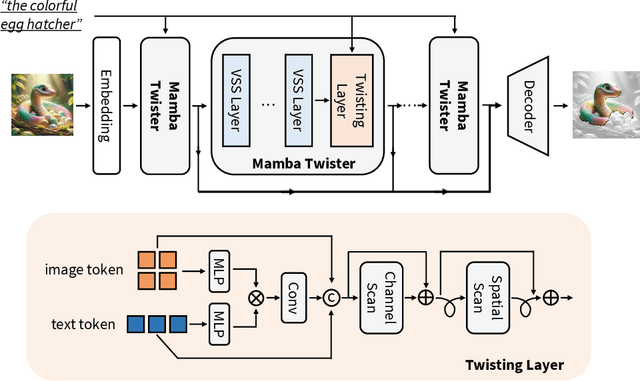
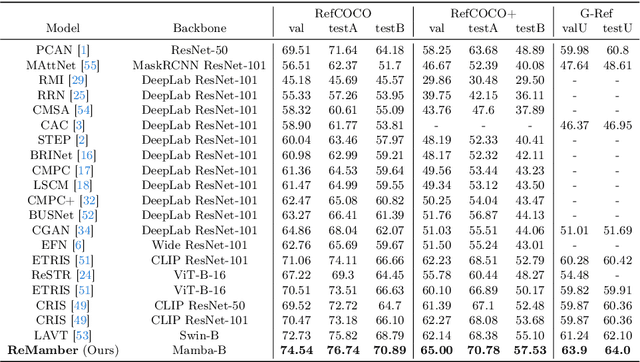
Abstract:Referring Image Segmentation (RIS) leveraging transformers has achieved great success on the interpretation of complex visual-language tasks. However, the quadratic computation cost makes it resource-consuming in capturing long-range visual-language dependencies. Fortunately, Mamba addresses this with efficient linear complexity in processing. However, directly applying Mamba to multi-modal interactions presents challenges, primarily due to inadequate channel interactions for the effective fusion of multi-modal data. In this paper, we propose ReMamber, a novel RIS architecture that integrates the power of Mamba with a multi-modal Mamba Twister block. The Mamba Twister explicitly models image-text interaction, and fuses textual and visual features through its unique channel and spatial twisting mechanism. We achieve the state-of-the-art on three challenging benchmarks. Moreover, we conduct thorough analyses of ReMamber and discuss other fusion designs using Mamba. These provide valuable perspectives for future research.
Uncovering Prototypical Knowledge for Weakly Open-Vocabulary Semantic Segmentation
Oct 29, 2023



Abstract:This paper studies the problem of weakly open-vocabulary semantic segmentation (WOVSS), which learns to segment objects of arbitrary classes using mere image-text pairs. Existing works turn to enhance the vanilla vision transformer by introducing explicit grouping recognition, i.e., employing several group tokens/centroids to cluster the image tokens and perform the group-text alignment. Nevertheless, these methods suffer from a granularity inconsistency regarding the usage of group tokens, which are aligned in the all-to-one v.s. one-to-one manners during the training and inference phases, respectively. We argue that this discrepancy arises from the lack of elaborate supervision for each group token. To bridge this granularity gap, this paper explores explicit supervision for the group tokens from the prototypical knowledge. To this end, this paper proposes the non-learnable prototypical regularization (NPR) where non-learnable prototypes are estimated from source features to serve as supervision and enable contrastive matching of the group tokens. This regularization encourages the group tokens to segment objects with less redundancy and capture more comprehensive semantic regions, leading to increased compactness and richness. Based on NPR, we propose the prototypical guidance segmentation network (PGSeg) that incorporates multi-modal regularization by leveraging prototypical sources from both images and texts at different levels, progressively enhancing the segmentation capability with diverse prototypical patterns. Experimental results show that our proposed method achieves state-of-the-art performance on several benchmark datasets. The source code is available at https://github.com/Ferenas/PGSeg.
Open-Vocabulary Semantic Segmentation via Attribute Decomposition-Aggregation
Aug 31, 2023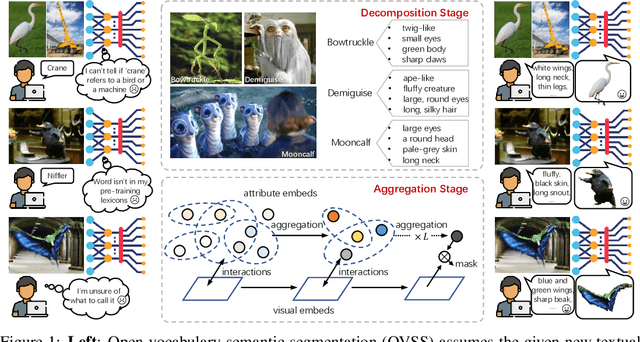



Abstract:Open-vocabulary semantic segmentation is a challenging task that requires segmenting novel object categories at inference time. Recent works explore vision-language pre-training to handle this task, but suffer from unrealistic assumptions in practical scenarios, i.e., low-quality textual category names. For example, this paradigm assumes that new textual categories will be accurately and completely provided, and exist in lexicons during pre-training. However, exceptions often happen when meet with ambiguity for brief or incomplete names, new words that are not present in the pre-trained lexicons, and difficult-to-describe categories for users. To address these issues, this work proposes a novel decomposition-aggregation framework, inspired by human cognition in understanding new concepts. Specifically, in the decomposition stage, we decouple class names into diverse attribute descriptions to enrich semantic contexts. Two attribute construction strategies are designed: using large language models for common categories, and involving manually labelling for human-invented categories. In the aggregation stage, we group diverse attributes into an integrated global description, to form a discriminative classifier that distinguishes the target object from others. One hierarchical aggregation is further designed to achieve multi-level alignment and deep fusion between vision and text. The final result is obtained by computing the embedding similarity between aggregated attributes and images. To evaluate the effectiveness, we annotate three datasets with attribute descriptions, and conduct extensive experiments and ablation studies. The results show the superior performance of attribute decomposition-aggregation.
Audio-aware Query-enhanced Transformer for Audio-Visual Segmentation
Jul 25, 2023Abstract:The goal of the audio-visual segmentation (AVS) task is to segment the sounding objects in the video frames using audio cues. However, current fusion-based methods have the performance limitations due to the small receptive field of convolution and inadequate fusion of audio-visual features. To overcome these issues, we propose a novel \textbf{Au}dio-aware query-enhanced \textbf{TR}ansformer (AuTR) to tackle the task. Unlike existing methods, our approach introduces a multimodal transformer architecture that enables deep fusion and aggregation of audio-visual features. Furthermore, we devise an audio-aware query-enhanced transformer decoder that explicitly helps the model focus on the segmentation of the pinpointed sounding objects based on audio signals, while disregarding silent yet salient objects. Experimental results show that our method outperforms previous methods and demonstrates better generalization ability in multi-sound and open-set scenarios.
Multi-Modal Prototypes for Open-Set Semantic Segmentation
Jul 05, 2023Abstract:In semantic segmentation, adapting a visual system to novel object categories at inference time has always been both valuable and challenging. To enable such generalization, existing methods rely on either providing several support examples as visual cues or class names as textual cues. Through the development is relatively optimistic, these two lines have been studied in isolation, neglecting the complementary intrinsic of low-level visual and high-level language information. In this paper, we define a unified setting termed as open-set semantic segmentation (O3S), which aims to learn seen and unseen semantics from both visual examples and textual names. Our pipeline extracts multi-modal prototypes for segmentation task, by first single modal self-enhancement and aggregation, then multi-modal complementary fusion. To be specific, we aggregate visual features into several tokens as visual prototypes, and enhance the class name with detailed descriptions for textual prototype generation. The two modalities are then fused to generate multi-modal prototypes for final segmentation. On both \pascal and \coco datasets, we conduct extensive experiments to evaluate the framework effectiveness. State-of-the-art results are achieved even on more detailed part-segmentation, Pascal-Animals, by only training on coarse-grained datasets. Thorough ablation studies are performed to dissect each component, both quantitatively and qualitatively.
Annotation-free Audio-Visual Segmentation
May 19, 2023



Abstract:The objective of Audio-Visual Segmentation (AVS) is to locate sounding objects within visual scenes by accurately predicting pixelwise segmentation masks. In this paper, we present the following contributions: (i), we propose a scalable and annotation-free pipeline for generating artificial data for the AVS task. We leverage existing image segmentation and audio datasets to draw links between category labels, image-mask pairs, and audio samples, which allows us to easily compose (image, audio, mask) triplets for training AVS models; (ii), we introduce a novel Audio-Aware Transformer (AuTR) architecture that features an audio-aware query-based transformer decoder. This architecture enables the model to search for sounding objects with the guidance of audio signals, resulting in more accurate segmentation; (iii), we present extensive experiments conducted on both synthetic and real datasets, which demonstrate the effectiveness of training AVS models with synthetic data generated by our proposed pipeline. Additionally, our proposed AuTR architecture exhibits superior performance and strong generalization ability on public benchmarks. The project page is https://jinxiang-liu.github.io/anno-free-AVS/.
Boundary-aware Supervoxel-level Iteratively Refined Interactive 3D Image Segmentation with Multi-agent Reinforcement Learning
Mar 19, 2023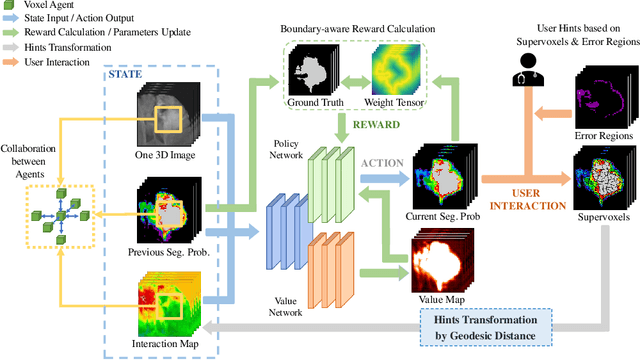
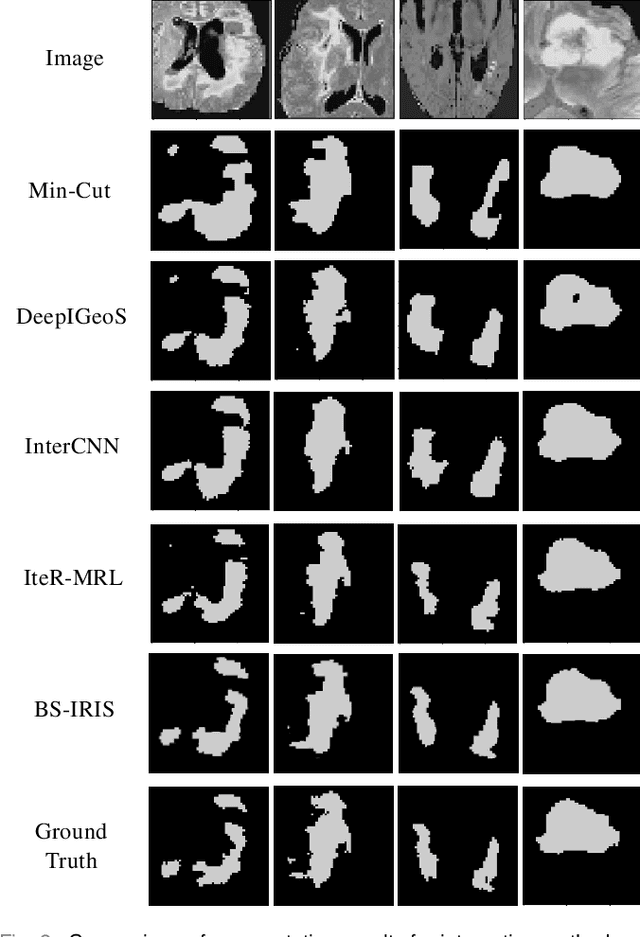
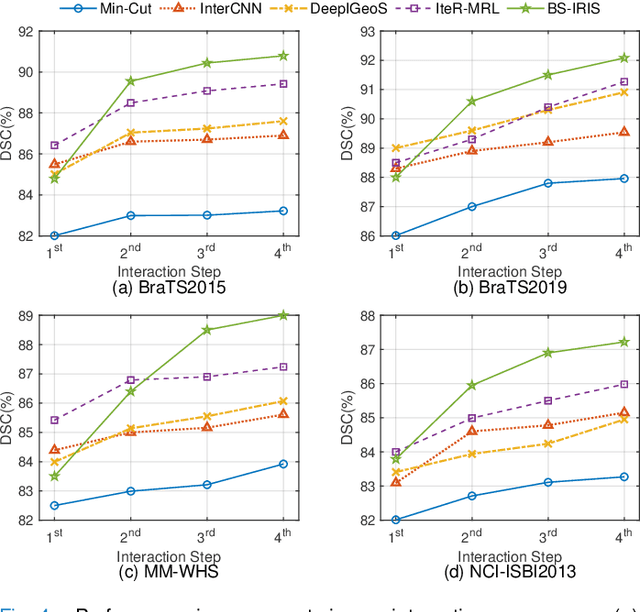
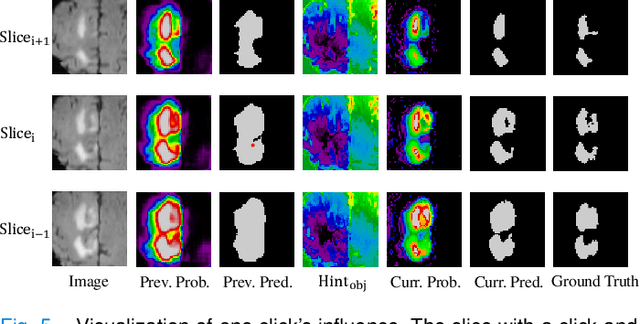
Abstract:Interactive segmentation has recently been explored to effectively and efficiently harvest high-quality segmentation masks by iteratively incorporating user hints. While iterative in nature, most existing interactive segmentation methods tend to ignore the dynamics of successive interactions and take each interaction independently. We here propose to model iterative interactive image segmentation with a Markov decision process (MDP) and solve it with reinforcement learning (RL) where each voxel is treated as an agent. Considering the large exploration space for voxel-wise prediction and the dependence among neighboring voxels for the segmentation tasks, multi-agent reinforcement learning is adopted, where the voxel-level policy is shared among agents. Considering that boundary voxels are more important for segmentation, we further introduce a boundary-aware reward, which consists of a global reward in the form of relative cross-entropy gain, to update the policy in a constrained direction, and a boundary reward in the form of relative weight, to emphasize the correctness of boundary predictions. To combine the advantages of different types of interactions, i.e., simple and efficient for point-clicking, and stable and robust for scribbles, we propose a supervoxel-clicking based interaction design. Experimental results on four benchmark datasets have shown that the proposed method significantly outperforms the state-of-the-arts, with the advantage of fewer interactions, higher accuracy, and enhanced robustness.
* Accepted by IEEE Transactions on Medical Imaging
DiffusionSeg: Adapting Diffusion Towards Unsupervised Object Discovery
Mar 17, 2023
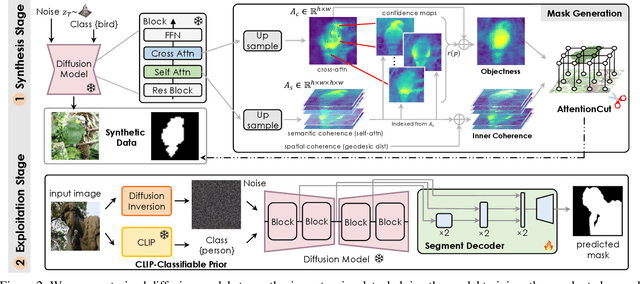


Abstract:Learning from a large corpus of data, pre-trained models have achieved impressive progress nowadays. As popular generative pre-training, diffusion models capture both low-level visual knowledge and high-level semantic relations. In this paper, we propose to exploit such knowledgeable diffusion models for mainstream discriminative tasks, i.e., unsupervised object discovery: saliency segmentation and object localization. However, the challenges exist as there is one structural difference between generative and discriminative models, which limits the direct use. Besides, the lack of explicitly labeled data significantly limits performance in unsupervised settings. To tackle these issues, we introduce DiffusionSeg, one novel synthesis-exploitation framework containing two-stage strategies. To alleviate data insufficiency, we synthesize abundant images, and propose a novel training-free AttentionCut to obtain masks in the first synthesis stage. In the second exploitation stage, to bridge the structural gap, we use the inversion technique, to map the given image back to diffusion features. These features can be directly used by downstream architectures. Extensive experiments and ablation studies demonstrate the superiority of adapting diffusion for unsupervised object discovery.
 Add to Chrome
Add to Chrome Add to Firefox
Add to Firefox Add to Edge
Add to Edge